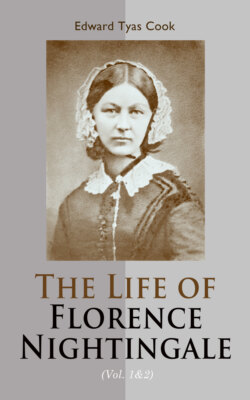Читать книгу The Life of Florence Nightingale (Vol. 1&2) - Edward Tyas Cook - Страница 16
II
ОглавлениеThe Nightingales had taken up their residence at Embley in September 1839, and remained there, in accordance with their wont, till the early summer following. The charm of the place is vividly described in a letter from Florence's sister to her cousin, Miss Hilary Bonham Carter:—
My Love—It is so beautiful in this world! so very beautiful, you really cannot fancy anything so near approaching to Eden or fairy-land, or il paradiso terrestre as depicted in the 25th Canto, stanza 40 something; so very, very lovely that we cannot resist a very strong desire that you should come down and see it. My dear, I assure you we are worth seeing. I never, though blest with many fair visions (both in my sleeping and my waking hours), conceived anything so exquisite as to-day lying among the flowers, such smells and such sounds hovering round me! Flo reading and talking so that my immortal profited too, and she comforted me when I said I must have much of the beast in me to be so very happy in the sunshine and the flowers, by suggesting that God gave us His blessings to enjoy them. So I am comforted, and set to work to enjoy with all my might, and succeed à merveille. Still the garden is big, there are many clumps of rhododendrons and azaleas, and showers of rosebuds, and I cannot be all round them at once; so we want you to come and help, not so much for your pleasure as to relieve the weight of responsibility, you see. … My love, I am writing perched on a chair on the grass, nightingales all round, blue sky above (such long shadows sleeping on the lawn), and June smells about me. Will you not come? The rhododendrons are early this year, and will be much passed in another ten days. Will you not come? If you ask learned men they will tell you June at Embley is a poetry ready made; and the first thing I shall do when I get to heaven (you'd better set about getting there Miss Pop directly, you're a very long way off at these presents), where I expect to have the gift of language, is to celebrate the pomps and beauties of the garden in this wicked world, than which I never wish for a better.
Florence and her sister loved each other, but their characters were widely different, as we shall hear, and their love at this time was not that of perfect sympathy, but rather of wistful admiration on the one side, and half-pitying fondness on the other. Parthenope looked upon Florence as upon some strange being in another world, whose happiness she passionately longed to see, and whose rejection of it she could but dimly understand. Florence, on her side, regarded her elder sister's contentment in the beauties of art and nature, and in the world as she found it, with the tender pity which one may feel for a happy child. “It would be an ill return for all her affection,” wrote Florence to one of her aunts, “to drag down my White Swan from her cool, fresh, blue sea of art into our baby chicken-yard of struggling, scratting14 life. How cruel it would be, as she is rocked to rest there on her dreamy waves, for anybody to waken her.” The difference in temperament between the sisters comes out very clearly in their several descriptions of Embley. Florence was sensible of its beauties, but they came to her with thoughts of a better world beyond, or with echoes from the still sad music of humanity in the world that now is. “I should have so liked you to see Embley in the summer,” she wrote,15 “for everything is such a blaze of beauty. I had such a lovely walk yesterday before breakfast. The voice of the birds is like the angels calling me with their songs, and the fleecy clouds look like the white walls of our Home. Nothing makes my heart thrill like the voice of the birds; but the living chorus so seldom finds a second voice in the starved and earthly soul, which, like the withered arm, cannot stretch forth its hand till Christ bids it.” A very different note, it will be observed, from that which Parthenope—and Pippa—heard from “the lark on the wing.” And so, too, with regard to the house at Embley. Mr. Nightingale had found it a plain, substantial building of the Georgian period. He enlarged it into an ornate mansion in the Elizabethan style. His wife and elder daughter were much occupied with the interest of furnishing it appropriately, and Mr. Nightingale was greatly pleased with his alterations. “Do you know,” said Florence, as she walked with an American friend on the lawn in front of the drawing-room, “what I always think when I look at that row of windows? I think how I should turn it into a hospital, and just how I should place the beds.”16
